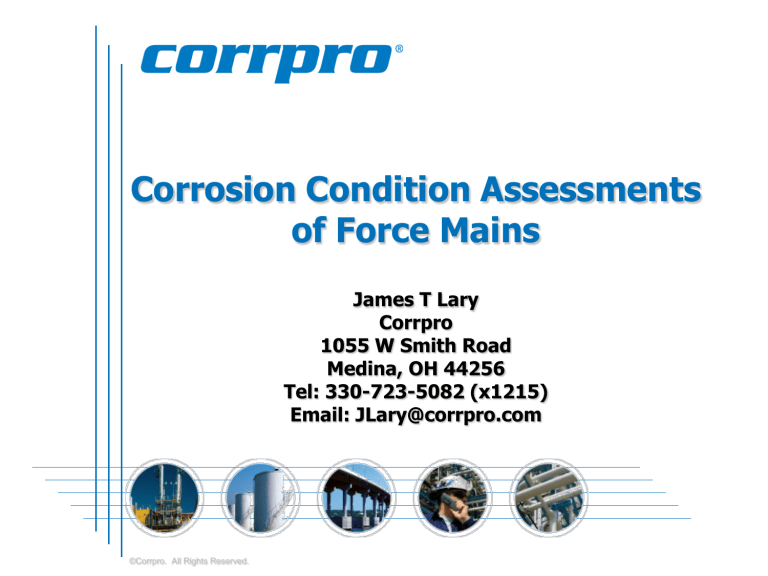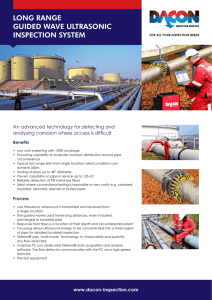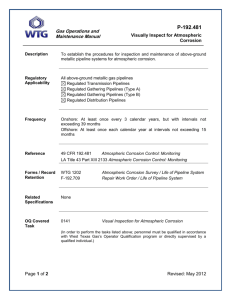
Corrosion Condition Assessments of Force Mains James T Lary Corrpro 1055 W Smith Road Medina, OH 44256 Tel: 330-723-5082 (x1215) Email: JLary@corrpro.com ©Corrpro. All Rights Reserved. IRON OXIDE REFINING IRON,STEEL,PCCP CORROSION MILLING IRON OXIDE Corrosion Process © Corrpro. All Rights Reserved. 2 Internal & External Corrosion of Force Mains…. H2S Anodic Area Solids Buildup © Corrpro. All Rights Reserved. 3 24” Ductile Iron Force Main Internal failure following loss of internal mortar lining Failure was along top of pipe due to formation of hydrogen sulfide gas © Corrpro. All Rights Reserved. 4 Dual 26” Force Mains Internal failures at bottom of pipe Failure following loss of internal mortar lining Failures concentrated at low areas (dips) in pipeline alignment Cause is corrosion under accumulated solids © Corrpro. All Rights Reserved. 5 36” Above Ground Crossing • Failure of force main at above ground crossing • Crown of pipe attacked by hydrogen sulfide gas © Corrpro. All Rights Reserved. 6 External Corrosion Caused by Aggressive soil conditions Galvanic Corrosion Stray DC Currents © Corrpro. All Rights Reserved. 7 External Corrosion Attack © Corrpro. All Rights Reserved. 8 1.58 in. 1.22 in. 0.94 in. 0.87 in. 0.58 in. 1908 CLD CI 1952 CL 150 CI 1957 CL 23 18/40 CI 1957 CL 22 21/45 CI 1976 CL 3 DI 0.43 in. 1985 CL 50 DI 0.38 in. 1991 CL 150 DI 0.21 in. Less Tolerances Actual size of AWWA Specification Thickness Reductions for 36-inch Diameter Cast and Ductile Iron Pipe - 1908 to Present (150 PSI Operating pressure) © Corrpro. All Rights Reserved. 9 Cast (Grey) Iron Failures Cast Iron Pipe (thicker walled pipe) © Corrpro. All Rights Reserved. 10 Ductile Iron External pitting (concentrated) corrosion attack on thinner walled ductile iron pipe. © Corrpro. All Rights Reserved. 11 Temporary Fix ? © Corrpro. All Rights Reserved. 12 The rate and magnitude of corrosion depends on a number of factors: Pipe Material and Characteristics Operating Conditions Construction Methods Environment (age not a good primary metric) Internal or External Corrosion Attack © Corrpro. All Rights Reserved. 13 Pipeline Condition Assessment Process Initial development driven by federally regulated pipeline integrity rules #1 – Pre Assessment #2 – Indirect Inspection Methodology also quite applicable to water / wastewater #3 – Direct Examination #4 – Post Assessment © Corrpro. All Rights Reserved. 14 #1 Pre-Assessment: Define pipe segments by construction contracts and similar characteristics, e.g. material, construction practices Identify specific locations along the pipeline Air Release Points/Man ways Pipeline crossings Known area where piping failures have occurred © Corrpro. All Rights Reserved. 15 #1 -Pre-Assessment Data Gathering & Planning: “Good listening” – operating history, criticality, consequences of failure Leak & Repair Records Pipe “Bone Yard” Coordination of Condition Assessment Efforts With Other Activities Excavations Repairs Project construction drawings and specifications Pipe materials and characteristics Wall thickness Pressure rating Flow Rates Air Release points/operational status Coatings and Linings Bedding and backfill material As-built documentation Soil corrosivity, e.g. resistivity, pH, chlorides, moisture Adjacent utilities and crossings Sources of stray current corrosion © Corrpro. All Rights Reserved. Nearby cathodic protection systems Direct current powered transit systems High voltage overhead AC power lines 16 #2 - Indirect Inspection: Indirect Inspection techniques: In-Situ Soil Resistivity Measurements Soil Sample Collection and Analysis Ultrasonic Thickness Measurements (if applicable) Direct Examination of Exposed Pipe Sections Stray Current Evaluations © Corrpro. All Rights Reserved. 17 #2 - Indirect Inspection: Integrate all data along pipeline alignment Analyze Data and Rank Indications: Severe Moderate Minor Select at sites for direct inspection – locations should be where corrosion activity is most likely Select control site where corrosion activity is the least likely © Corrpro. All Rights Reserved. 18 #3 - Direct Examination Excavating the pipe Performing physical inspection & photograph Evaluating integrity of coating/wrap, if present Testing the pipe surface, e.g. corrosion pitting UT measurements Measuring dimensions of corrosion defects Analyzing surrounding soil / groundwater Performing root cause analysis © Corrpro. All Rights Reserved. 19 Force Main Pipeline Inspection Report Inspector name_________ 1) Type of Pipe: cast iron_____ Date____ Address of pipeline inspection ________________ ductile iron____ carbon steel___ copper______ carbon steel_____ 2) Diameter of pipe _____” Pipeline Name_________ Service Type: Water____ Wastewater____ Leak? Yes____ No____ File Number:_____________ non metallic_____ concrete________other____ Estimated date of pipe installation______ Depth of pipe______’ 3) Type of Pipe: Distribution____ Transmission____ Service_____ Hydrant _____ Mechanical joint_____ Fasteners_____ Other____ Unknown____ 4) Type of Coating: Polyethylene Encased____ Shop applied coating___ No Coating____ Tape Wrap____ Unable to determine____ 5) External Pipe Condition: Very Good____ Good____ Poor____ comments:____________________________________________________________________ ___________________________________________________________________________________________________________________________________________ 6) Ultrasonic Thickness Measurements and comment______________________________ 6) Is corrosion pitting evident? ____ Yes ____ No Number of Pits______ Internal Lining Present _____ Yes ____No comment_________________ Typical Size of Pits______ Quantity of pits:______ 7) Is graphitization evident (longitudinal or circumferential breaks) ____Yes ____ No 8) Is the pipe installed in (check off appropriate items): Industrial area____ Residential area____ Rural area____ Near street or road ____ Near creek or waterway ____ In reclaimed land___ Near oil or gas pipelines____ Near high voltage lines ____. 8) Describe soil conditions where inspection occurred: wet____ dry____ clay soil ____ rocky soil____ cinders ____ other____________________ 9) Where soil samples obtained, sealed and analyzed for chlorides, moisture content, pH, sulfides, resistivity? If yes results were: _____________________________ 10) Were previous repairs made on the pipeline (leak clamps, etc) Yes____ No ____. Was new pipe installed____ Yes ____ No. 11) Was a repair clamp installed on the pipe during inspection ___ Yes ___ No 12) Was a galvanic anode installed as part of the inspection process? ___ Yes ___ No, if yes size and quantity 13) Please relay additional comments: _____________________________________________________________________________________________________________________________________ _____________________________________________________________________________________________________________________________________ _____________________________________________________________________________________________________________________________________ 14) Plan of Action____________________________ 15) Insert digital photos below: © Corrpro. All Rights Reserved. 20 #3 - Direct Examination: When corrosion is found, perform a root cause analysis Implement localized corrosion protection Install instrumented test station for future assessment of corrosion activity, e.g. corrosion rate probes © Corrpro. All Rights Reserved. 21 #4 – Post Assessment: © Corrpro. All Rights Reserved. Corrosion rate Uac Jdc 1000 20 900 10 800 0 700 -10 600 -20 500 -30 400 -40 300 -50 200 -60 100 -70 0 17/03/06 JDC A/m2 Uac (V) Pit growth rate and wall thickness Internal or External Corrosion Coupons Electrical resistance (ER) probes Maximize benefit by Capture ideas for improvement Determine need/timeframe for update evaluations Identify corrective action options Probe-Tag: 5500 K11A-1 Probe Type: PA-0.4-10-0.1-6 Probe serial No.: PA04270025 Test initiated: 20-12-2005 AC current - A/m2 Corrosion rate micron/y Calculate remaining life 18/03/06 19/03/06 20/03/06 21/03/06 22/03/06 23/03/06 24/03/06 -80 25/03/06 Date 22 #4 – Post Assessment Recommendations: Identify Corrective Options Operational Procedures Treatment Practices Internal Lining Cathodic Protection Stray Current Mitigation Pipeline Replacement Pipeline Monitoring © Corrpro. All Rights Reserved. 23 Program for Existing Mains Break Reduction Life Extension Through Cathodic Protection © Corrpro. All Rights Reserved. 24 Anode Lead Wire Connection Pipe Galvanic Anode Metallic Coupling Cathodic Protection of Metallic Fitting ©Corrpro. All Rights Reserved. Meter Vaults (Keep dry if possible) © Corrpro. All Rights Reserved. 26 Impressed Current CP System on Oil/Gas Lines can Create Stray Current Problem on Water Lines © Corrpro. All Rights Reserved. 27 Summary Effective management of force mains pipeline includes understanding and managing the risk of corrosion A systematic approach to condition assessments results in the most value at the lowest cost Retrofitting with accepted industry practice such as internal linings, treatment programs, operational adjustments, or cathodic protection may be a cost effective options for extending the life of existing mains A key asset management strategy is to include suitable corrosion control in the design of new force mains © Corrpro. All Rights Reserved. 28 Other Structures © Corrpro. All Rights Reserved. 29 Thank You James T Lary (330) 723-5082 ext 1215 JLary@corrpro.com ©Corrpro. All Rights Reserved. Criteria No. 2 Approach to the Project and Methods Used to Plan, Design, and Administer the Project Prioritizing Distribution Systems Retail Industry School © Corrpro. All Rights Reserved. 31 Program for Existing Mains Break Reduction Life Extension Through Cathodic Protection Anode Installation © Corrpro. All Rights Reserved. 32 25 100 Breaks Prior to Cathodic Protection 3 Breaks After Cathodic Protection Number of Breaks 20 15 1988 C.P.Totals Length Protected = 12,780 feet 10 5 0 74 75 76 77 78 79 80 81 82 83 84 85 86 87 88 89 90 91 92 93 94 95 Year © Corrpro. All Rights Reserved. 33 Copper Service Connections © Corrpro. All Rights Reserved. 34 Stray Current © Corrpro. All Rights Reserved. 35 Polyethylene Encasement of Ductile Iron Pipe -Follow DIPRA installation procedures -Clean pipe before installing polywrap -Repair tears or damage to encasement -Engage an inspector to oversee installation © Corrpro. All Rights Reserved. 36 Insituform © Corrpro. All Rights Reserved. 37 Repair of Break Should Include Anode Installation Completed Repair © Corrpro. All Rights Reserved. 38 Lower Stress Area (Cathode) Pipe Threaded Bolt Higher Stress Area (Anode) Metallic Coupling Stress Corrosion ©Corrpro. All Rights Reserved. Polyethylene Encasement of Ductile Iron Pipe -Follow DIPRA installation procedures -Clean pipe before installing polywrap -Repair tears or damage to encasement -Engage an inspector to oversee installation © Corrpro. All Rights Reserved. 40 Force Main Recommendations Use coatings and cathodic protection for external corrosion control of steel and ductile iron pipe Replace pipe at failure sites with PVC, HDPE or fiberglass For long sections of deteriorated pipe, replace with PVC, HDPE or fiberglass, or, internally line with cured in place polyester resin (CIPP) Where metallic piping must be used, line with ceramic epoxy. © Corrpro. All Rights Reserved. 41 History of Iron Pipe Cast Iron - Introduced to North America during the 1800’s and installed till the 1970’s. - Early on, statically cast process produced a thick walled, heavy pipe. - No longer produced in North America. Ductile Iron - Introduced in 1955 as an improvement to cast iron. - Centrifugal casting process produces a thinner walled, lighter pipe which is stronger and more ductile than cast iron. © Corrpro. All Rights Reserved. 42 © Corrpro. All Rights Reserved. 43 Anode Installed on Metallic Fitting © Corrpro. All Rights Reserved. 44 Investigative Structure (Existing) Corrosion Assessment Review of General Characteristics of Water System - Age - Material Type - Wall Thickness - Construction Practices Review Break / Leak History Field Survey - Soil Conditions (Resistivity, Moisture Content, Chemical Analysis) - Electrical Test Data Analysis & Risk Management Priority Index (Identification of Opportunities to Reduce Replacement / Repair Costs) © Corrpro. All Rights Reserved. 45 Effectiveness of Well Designed Corrosion Management Programs CUMULATIVE BREAKS 1000 665 breaks projected without protection after 25 years Cathodic Protection applied at Year 17 94 breaks after 17 years 100 10 3 breaks after 8 years 1 0 5 10 15 20 25 30 YEARS AFTER INSTALLATION © Corrpro. All Rights Reserved. 46 Value of Well Designed Corrosion Management Programs Benefit to Cost Ratios ($ saved/ $ spent): City of Houston, TX 8 Marin Water District, CA 9 East Bay MUD, CA - All Facilities 7 Annualized Costs – 20 Yr. Cycle Life Extension Cathodic Protection 58% less expensive than continuing with repairs $12,000 $10,000 East Bay MUD, CA - Steel Pipelines 24 $8,000 $6,000 Chicago Area Utility 25 $4,000 $2,000 $- REPLACEMENT © Corrpro. All Rights Reserved. CONTINUE REPAIRS CATHODIC PROTECTION 47 Existing Force Mains: Internal Corrosion is likely the leading cause of main breaks External Corrosion may also be a factor © Corrpro. All Rights Reserved. 48 #2 – Indirect Inspection: Non-Invasive Over-the-Line Techniques © Corrpro. All Rights Reserved. 49 Existing Force Mains: Condition Assessment …need to cost effectively understand and manage pipeline condition and operational risk… Criticality Scale 1 2 3 5 Objective 1: Thorough Understanding of High Risk Regions 5 Condition 4 4 3 2 Objective 2: Cost Effective Field Evaluation 1 © Corrpro. All Rights Reserved. 50 The four fundamental elements of a successful coating system involve: 1. 2. 3. 4. Material Selection Specification Application Inspection © Corrpro. All Rights Reserved. 51 Technologies Material Selection Protective Coatings Cathodic Protection Stray DC Current Control AC Interference Mitigation © Corrpro. All Rights Reserved. 53 24” DIP Multiple failures at Buffalo Bayou on bottom of pipe Performed ultrasonic thickness measurements in lift station Cases of failure are scouring and turbulent flow © Corrpro. All Rights Reserved. 54 Force Main Corrosion Mechanisms © Corrpro. All Rights Reserved. 55 30” Ductile Iron Internal corrosion failure at crown of pipe. Hydrogen sulfide gas formed sulfuric acid which attacked the mortar coating and then the underlying metal surface. © Corrpro. All Rights Reserved. 56 H2S & Silt Accumulation May Cause Internal Corrosion Problem…. H2S SILT ACCUMULATION © Corrpro. All Rights Reserved. 57 Piping Inspection Phases 1. Identification of Problem or High Consequence Areas 2. Field Study/Inspection 3. Post Assessment/Identify Corrective Options © Corrpro. All Rights Reserved. 58 Accurate leak records are an invaluable predictive tool CUMULATIVE BREAKS 1000 665 breaks projected without protection after 25 years 100 94 breaks after 17 years 10 3 breaks after 8 years 1 0 5 10 15 20 25 30 YEARS AFTER INSTALLATION © Corrpro. All Rights Reserved. 59 #2 – Indirect Inspection: Data Integration for Non-Invasive Over-the-Line Techniques © Corrpro. All Rights Reserved. 60 #2 - Indirect Inspection: Available decision-assisting tools, among others: DDMTM – Risk-based “Design Decision Model” MTCFSM – “Mean Time To Corrosion Failure” Predictive Model C O N S E Q U E N C E DDMTM LIKELIHOOD OF CORROSION © Corrpro. All Rights Reserved. 61 #3 - Direct Examination: Excavating the pipe Performing physical inspection Evaluating integrity of coating/wrap, if present Ultrasonic Testing of the pipe surface Measuring dimensions of corrosion defects Analyzing surrounding soil / groundwater Obtain coupon Performing root cause analysis © Corrpro. All Rights Reserved. 62 24” DIP & Steel Internal pipe failures along crown of pipe Failures following loss of internal mortar lining Cause is formation of hydrogen sulfide gas © Corrpro. All Rights Reserved. 63 #3 - Direct Examination: Procedures for data collection Physical Examination Photographic Documentation Pipe-to-Soil Potential Measurements Bi-metallic Connections, e.g. services Soil, Bedding, Backfill and Groundwater Tests Coating Assessment (if applicable) Mapping and Measurement of Corrosion Defects Ultrasonic Thickness Measurements AC and DC Stray Current Measurements © Corrpro. All Rights Reserved. 64



